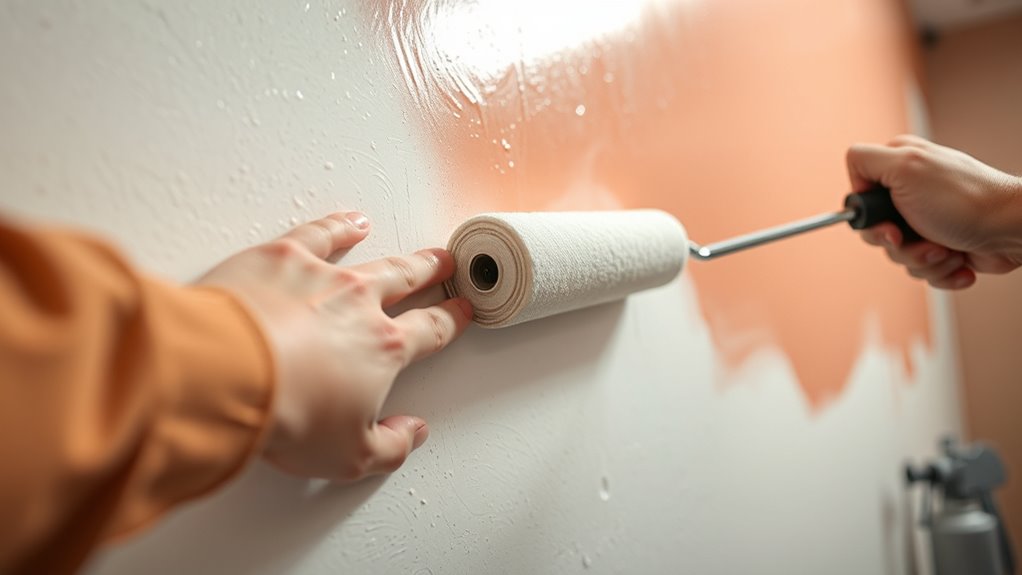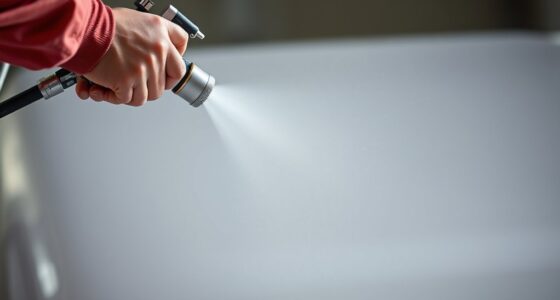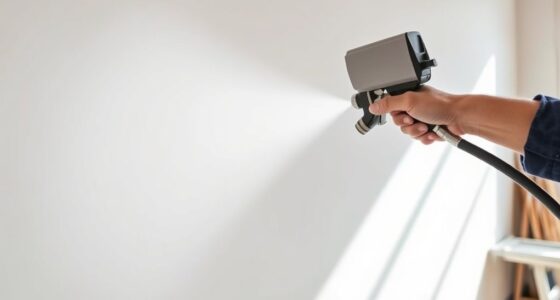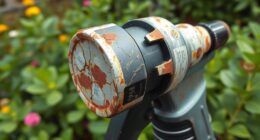You should back-roll right after spraying while the paint is still wet. This helps guarantee even coverage, remove runs or thick spots, and embed the coating into the surface for better adhesion. Using the right roller for your surface and applying gentle pressure can make a big difference. Proper back-rolling improves the finish’s smoothness and durability. To learn more about the best techniques and tips for perfect results, keep exploring the most effective methods.
Key Takeaways
- Back-roll while the paint is still wet to improve adhesion and embed coating into the surface.
- Use back-rolling after spraying to smooth out uneven coverage and eliminate drips or thick spots.
- Perform back-rolling on textured surfaces with appropriate rollers for a uniform finish.
- Back-rolling enhances coating durability and prevents peeling or flaking over time.
- It is most effective immediately after spraying, ensuring optimal bond and a professional appearance.

Back-rolling after spraying is a essential step to guarantee even coverage and proper adhesion of paint or coatings. When you spray a surface, the paint particles can sometimes settle unevenly, creating thin spots or drips. Back-rolling helps smooth out these imperfections, ensuring that the coating is uniform and adheres well over time. This technique is especially critical when working with surfaces that require high-quality finishes or when using thicker paints and coatings. Without proper surface preparation, such as cleaning, sanding, or priming, the paint may not bond correctly, leading to peeling or flaking down the line. That’s why integrating back-rolling into your process boosts both the durability and appearance of your work.
To start, you need to think about the surface you’re working on. Proper surface preparation is key to achieving ideal paint adhesion. Remove any dirt, grease, or loose material before spraying. Lightly sanding glossy or uneven surfaces can create a better profile for the paint to grip onto. When you spray, the paint’s ability to adhere depends heavily on the surface’s cleanliness and texture. If you skip surface prep, the paint might not stick evenly, leading to peeling or uneven coverage. Back-rolling is most effective when the surface has been correctly prepared, as it helps embed the coating into the surface, ensuring it bonds securely. Additionally, understanding paint adhesion principles can help you choose the right coatings and techniques for lasting results.
The actual act of back-rolling involves using a high-quality roller to go over the freshly sprayed area. You want to do this while the paint is still wet, so the coating can be worked into the surface. Use a medium-nap roller for textured surfaces and a smooth roller for flat, smooth surfaces. As you back-roll, apply gentle pressure to distribute the paint evenly, pushing it into any pores or imperfections. This step helps eliminate thick spots, runs, or drips that can form during spraying. By doing so, you improve the overall finish and reduce the need for touch-ups later.
Frequently Asked Questions
Can Back-Rolling Be Done on All Types of Sprayed Surfaces?
You can’t back-roll on all sprayed surfaces because surface compatibility varies. It’s best suited for porous or textured surfaces like drywall or stucco, where it helps improve coating adhesion. Avoid back-rolling on smooth, non-porous surfaces like metal or glass, as it may cause uneven coverage or damage. Always assess the surface type and manufacturer recommendations to guarantee proper adhesion and a quality finish.
How Long Should I Wait Before Back-Rolling After Spraying?
You should wait at least 15 to 30 minutes after spraying before back-rolling, depending on the drying time indicated by the product instructions. This guarantees the surface has started to dry and won’t be disturbed during back-rolling. Proper surface preparation is essential, so avoid rushing, as premature back-rolling can damage the finish. Always check the manufacturer’s recommended drying time for ideal results.
Does Back-Rolling Affect the Durability of the Coating?
Back-rolling can actually enhance the coating’s durability by improving surface integrity and ensuring even coverage. When you back-roll properly, you help the coating bond better to the surface, which can extend its lifespan. This process minimizes chances of peeling or cracking, ultimately boosting coating longevity. So, if done correctly, back-rolling supports your goal of a long-lasting, durable finish that maintains its appearance over time.
What Tools Are Best for Effective Back-Rolling?
You need the right tools to back-roll effectively. Use high-quality roller brushes or paint rollers with the appropriate nap length for your surface. A smooth, dense roller helps evenly distribute the coating, preventing streaks and ensuring durability. Keep a sturdy roller handle for control, and consider extension poles for hard-to-reach areas. With these tools, you’ll achieve a flawless finish that lasts, transforming your project with ease and confidence.
Are There Environmental Considerations When Back-Rolling?
Yes, environmental considerations matter when back-rolling. You should be mindful of the environmental impact, especially regarding paint runoff and VOC emissions. To practice eco-friendly methods, choose low-VOC or zero-VOC paints and use proper disposal techniques for leftover materials. Additionally, work in well-ventilated areas to reduce airborne pollutants. By adopting these eco-friendly practices, you minimize your environmental footprint while ensuring a quality finish.
Conclusion
Back-rolling might seem like an extra step, but it transforms your spray job from okay to exceptional. It’s the difference between a surface that merely looks painted and one that’s truly protected. You’ll find that taking the time to back-roll creates a smoother finish, sealing the paint in and reducing imperfections. So, when you spray next time, remember—back-rolling isn’t just an add-on; it’s the secret to lasting, flawless results.









